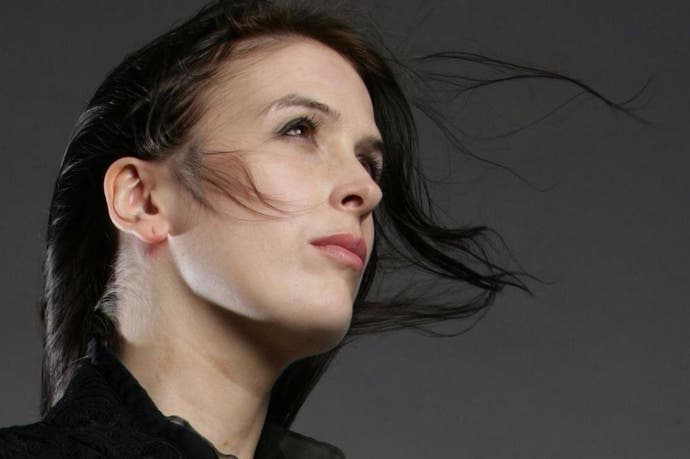Writing Lara Croft
How Rhianna Pratchett helped reboot Tomb Raider.
Back in 2010, after a stint working on the early version of Eidos Montreal's Thief reboot, Rhianna Pratchett set to work writing a very different Lara Croft. The brief from developer Crystal Dynamics was clear: this new Tomb Raider would be a reboot for the long-running series, a game that would drag Lara Croft kicking and screaming into the modern era. For Pratchett, that meant helping craft a personality for a younger Lara, an origin story in which the world's most famous video game action hero could find herself.
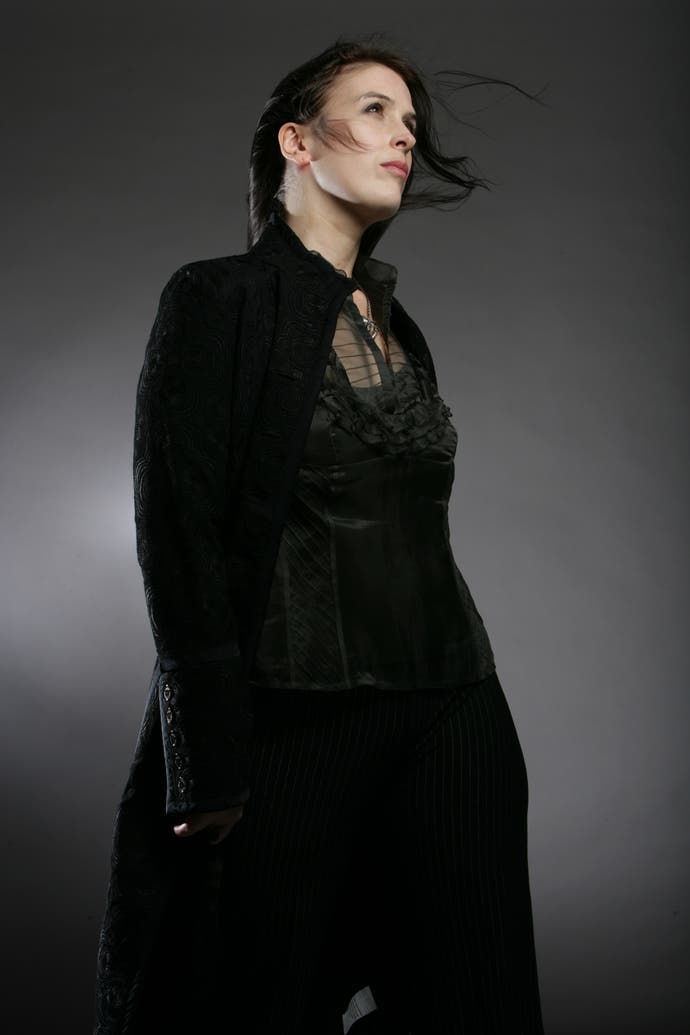
"They talked about it in the way in which Batman and James Bond were rebooted," Pratchett tells me over Skype. "We talked about Lara being depicted at a younger age. They'd had a lot of feedback from fans who wanted to see the adventures of a younger Lara, so they knew there was an appetite out there for it."
When Pratchett began work on the series, Crystal Dynamics already had a number of Tomb Raider games under its belt, having taken over development duties from Lara's creator, Core Design, in the mid-2000s. The studio felt it had the credibility to reboot the franchise - one of the most iconic in all video games - and had come up with a bold new vision to make the reboot worthwhile.
Rhianna Pratchett is an external writer. She works for studios - rather than inside of them - to help craft narratives. And so, when she came onto Tomb Raider after one of the producers on Thief recommended her to one of the executives at Crystal, much had already been decided.
Pratchett's focus was on Lara and her evolution, rather than the setting of the game or its mechanics. "I wanted to make her more relatable in this day and age and in this current climate, and not have her as the millionaire playgirl jetting around the world with all the guns and gadgets, in the way she had in the classic incarnation," she says.
"As fun as it was, we're probably not as keen to see that repeated again. So she was a bit more of a regular girl. She took on jobs to get herself through university. She's rejected her family's wealth and was just trying to make it on her own as a more or less average student. Of course, she turns out to be anything but. But she's just trying to get by in the way all students are."
The idea was that real life would slap Lara Croft in the face, as it does to so many who leave university thinking they know it all. Except, for Lara Croft, this involved getting shipwrecked on an island full of mad cultists.
Pratchett's big challenge was arguing the toss for narrative in a game made up of so many different parts by hundreds of people. This is a problem common inside of big-budget video game development, where writers are trying to portray a character against the backdrop of action-heavy gameplay. How do you draw a nuanced character when gameplay needs its own pacing, when gameplay needs to be fun?
This problem manifested itself during the "Lara's first kill" scene. Crystal Dynamics had talked much about how this crucial moment in the young Lara's development would go down, but for Pratchett it was a battle between gameplay and narrative - a battle narrative eventually lost.
"Narrative wanted a slower ramp-up," Pratchett says. "The playtesters, we'd given the player a gun and they wanted to use the gun. The gameplay just wanted to put fun, interesting gameplay in there and support what the player wanted.
"That was something we got dinged for, and we knew we would. But that was a battle that was laid out. It didn't go narrative's way. I wouldn't say that many battles do. Some you win. Some you lose. You have to get used to losing more than you win."
Lara's first kill moment would become one of the defining scenes in the Tomb Raider reboot - and not for all the right reasons. A few seconds of an E3 2012 trailer sparked a controversy that would go on to dog the developers in the run up to the March 2013 release. We see a cultist put his hand on the hip of a battered and bruised Lara Croft. She struggles, before the man kisses her neck. She fights back, struggles for control over a gun, before shooting the man dead.
The trailer gave the audience the impression the series' young heroine would be beaten, bruised, kidnapped, and finally subjected to an attempted rape. UK newspaper The Sun picked up the story, running the headline: "Lara Croft's 'rape' ordeal in video game hell."
When the controversy blew up over E3 2012 week, Rhianna Pratchett had yet to be announced as the writer for the game. She had to bite her lip, frustrated at her inability to leap into the debate to provide context.
"It was a shame really," she says, over four years after the event. "There are some people who still believe the first thing they read about it. We learnt a thing or two about how to cut trailers. We on the developer side knew the entire context around the scene and all that was happening. I'm not entirely sure we factored in how it might look, cut against lots of quick scenes."
Pratchett says the controversy took the developers by surprise because "it's so common in every other entertainment media, to a much greater extent".
"You could see what actually happens in the game to Lara, ie, the guy getting very handy, you can see that in an average soap opera in the UK. Okay, it's probably not going to end up with the death of either one of the characters, but I think that took us by surprise."
Pratchett explains what the team was going for with the scene.
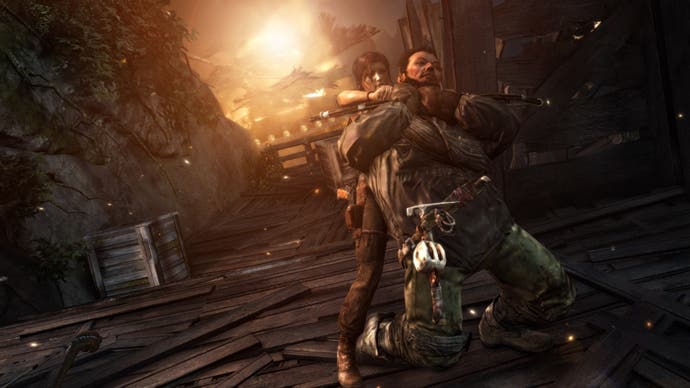
"We're not using rape as character development," she says. "This is a challenge Lara has to go through. She's gone through challenges before and she goes through challenges afterwards. This isn't like the radioactive spider bite that turns her into a Tomb Raider. This is a situation she has to deal with and it leads to the first kill. So it's not really about the guy's actions. It's about Lara's reactions.
"We thought this particular character would have done the same to frighten and exert power over a young man, as well. It's an island full of all male cultists. It's not a nice place. We were careful in what we depicted."
The Lara Croft rape controversy was fuelled by comments from an executive producer on the game, who told Kotaku players want to "protect" the new, less curvy Lara Croft. Amid the din surrounding the debate about Tomb Raider's rape scene, as glimpsed at in a trailer, the comment did not go down well.
"He'd taken that from playtesting feedback," Pratchett says, "and had maybe not necessarily thought about how players have different connections to the character.
"I understand that bit because it was coming straight from the comments some playtesters had made. I don't think he was even saying that in context with that scene. It all kind of got lumped together. It's true players have different relationships with the player character. Some feel they're on a journey with them. Some feel they have to protect them. Some feel that they are them."
A few weeks after E3 2012, Pratchett was announced as the writer of Tomb Raider. Some suggested the announcement was PR damage control, but Pratchett says the timing was part of a plan set in stone months prior. Whatever the case, she was - finally - able to discuss the scene.
"Once I was announced as the writer I was like, okay, let's talk about it," she says. "Obviously this has come as a surprise to people. Let's not pretend it's not happening. Let's just talk about it. That helps. When I could talk about the scene in context and why it was there and that it was part of a wider narrative, that calmed it a little bit. But there are still people who think it's a rape simulator. I don't know what you can do about that, really."
Over four years later, Pratchett is philosophical about the whole thing, although she's still surprised about the controversy.
"Something like that would never be a controversy in anything else," she says. "There were some people who said, you can't do that to Lara. That would never happen to Lara, which is a disturbing line to take, to suggest there are women, albeit fictional ones, that that sort of thing doesn't happen to and shouldn't happen to. It's like, well, it shouldn't happen to any woman, but in fact things like that happen to all women in all walks of life. Just because you're seen as a tough video games character, that doesn't mean that sort of stuff wouldn't happen to you."
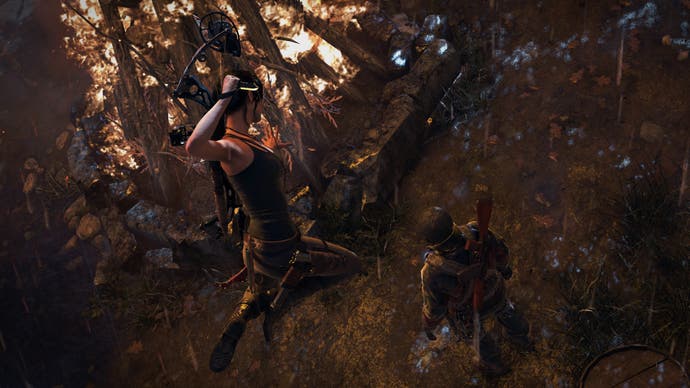
Crystal Dynamics began work on follow-up Rise of the Tomb Raider behind the scenes as it wrapped up the 2013 reboot. As with Tomb Raider, Crystal had already settled on the overarching story, but Pratchett was charged with seeing the evolution of the Lara Croft character through.
By this point, Lara's character had evolved so she was less reactive, as she had been throughout the reboot, and more proactive. Comics penned by Pratchett had filled in the gap between the events of the two games, but you didn't need to have read them to see Lara had taken a significant step along the path to becoming the Tomb Raider she was destined to be.
Rise of the Tomb Raider is set one year after the events of Tomb Raider. Lara, suffering from post-traumatic stress disorder from having to kill a whole bunch of cultists on an island, turns to her late father's research into the lost city of Kitezh and the promise of immortality. The game can be seen as Lara coming to terms with her father's death, and unravelling the truth behind it.
Rhianna Pratchett, at least at first, was not a fan.
"I've been open about the fact I wasn't that into the father storyline to start with," she says, "but eventually found peace with it, and I think we did some good things with it.
"When you're talking about teams of hundreds of people, you are really a cog in the machine. The narrative team is important, but so are all the other teams as well, and they're all fighting for space and agency and budget and time and everything else."
Pratchett was nervous about how Rise of the Tomb Raider would be received. "With the first game we had the element of surprise," she says.
"With the second game, we didn't have that element of surprise. People had already been on one adventure with Lara. We weren't sure how well the evolution of her character would come across, how people would feel about it. How would they respond to a tougher Lara? The Lara who is more vulnerable and human in the first game, she's moved on from that.
"But we found players had moved on with her. They had been through the adventures. They knew what she'd been through. They'd walked through the fire with her. So they felt toughened by what they had been through in the past with her. That aligned player and player character rather nicely."
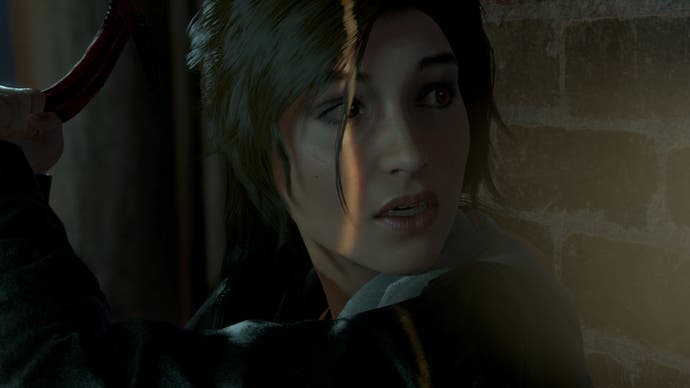
When I ask Pratchett what she would change about the Tomb Raider games she worked on, she's quick to point to a couple of parts of the 2013 reboot: Lara's first kill, and the ending of the game.
"I would have liked for us to have found a more elegant solution for the first kill and what happened after it," Pratchett says.
"It would have been good if we had taken more time to think about how the character would come across in that situation. Maybe you could have had her throw away the gun off a cliff. It would feel in-line with how the character is feeling. You would be maybe a bit frustrated as a player, but you'd also feel, okay, well that feels in-line with what the character's going through and it would seem natural for her to do that.
"And then she would have to have a bit more gameplay where she's stealthing. She has the bow at that point, so maybe she just has to keep using the bow for a bit, and eventually she's in a situation where she's going to have to pick up a gun again. That's the moment she realises that's what she's going to have to do to get through it. I would have liked to have stretched out those realisations rather them all coming boom boom boom in the same scene. That's something I would have liked to have done."
And then there's the ending of the first game. Originally, it had a darker, more downbeat ending that would hammer home the theme of sacrifice versus loss. But player feedback suggested the game had too many character deaths already, so by the time the player got around to the end, it all felt a little depressing.
"Originally, when I'd written the first draft of the script, there wasn't so much death in it," Pratchett explains. "And then, gradually the deaths crept in, and it changed the feel of the narrative. It made more sense the players were feeling that way after they'd gone through various other deaths."
Because of the feedback from playtesters, the ending had to be changed at "almost the eleventh hour". "There had been a lot of death up to that point. Part of that was the gameplay changes, where I had to keep going back and killing off characters," Pratchett says.
"It would have been good if we'd identified that problem earlier, and we probably could have finessed things a bit more. It wasn't too late. We managed to fix it. But it didn't fully deliver on some of the narrative themes we wanted to. We folded them back into the second game."
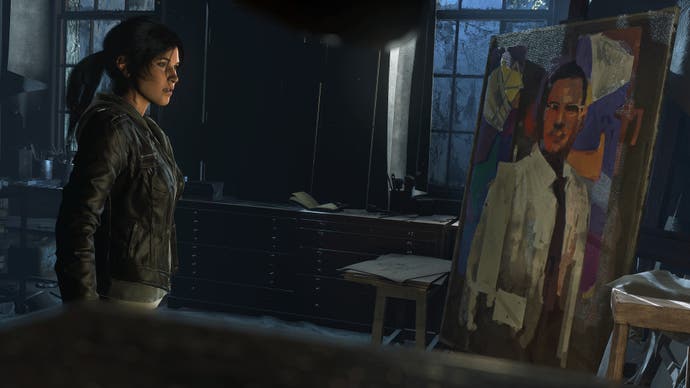
Speaking to Pratchett, I get the impression she's glad she got the chance to right some of the narrative wrongs of Tomb Raider with Rise. And from a production point of view, she, along with the rest of the narrative team, tried their best to identify story issues as early as possible, avoiding troublesome eleventh hour changes.
But, by doing so, new problems presented themselves.
"That did mean as writers and narrative designers that we were in constant headwinds of feedback all the time," Pratchett says, "from the team, Microsoft, Square Enix, external contractors, internal playtesters, external playtesters. It was very very full-on.
"That was very hard to deal with, because you're constantly reiterating all the time, and obviously different people have different tastes and different levels of power, and you've got to react to everything, and you're trying to keep everyone happy and also deliver on your creative vision. It's what I imagine working on a big budget studio picture is like. It's a bit like writing a script with the entire audience behind you, watching you and giving comments.
"But it did help us identify potential problems, like problems with the ending or those moments where narrative and gameplay really clash a lot earlier on, so that meant we could finesse those problems more and smooth out the edges."
One of the issues I had with the Tomb Raider reboot was I felt it struggled to marry the fact Lara - via the player - breezily murders hundreds of people, with the suggestion she's simply an adventurous student who up until the events of the game had never killed anyone before. It's a different problem to the Nathan Drake mass murderer issue that has dogged the Uncharted series, but it's along the same lines.
Pratchett calls this the "biggest challenge" she faced writing Lara Croft. "Uncharted has made Drake more lighthearted about it," she says. "With Lara, we wanted to make her care a little bit and be a bit more human in her reactions, but ultimately realise this is what she's got to do to survive and just get on with it."
Rise, as you'd expect, dealt with this issue more smoothly because the experience of the first game meant her ability to kill was more believable.
"By the time Rise comes along, she's ready to meet fire with fire," Pratchett says. "She knows what she's doing, and she almost enters a mode to deal with it. This isn't her first rodeo."
Some, however, struggled to get on with this new, modern Lara in either game. Critics say Pratchett and Crystal Dynamics veered too far from the Lara of old, the Lara envisioned by Core Design's enigmatic Toby Gard, into "grim-dark" territory.
"There is a tonal difference," Pratchett admits. "Crystal is very keen not to do the quippy one-liner Lara that characterised classic Lara. There's a part of me that misses that. I know there are players who miss that. From a writer's point of view, it's fun to write that kind of character.
"But quippyness and the devil-may-care attitude suggests confidence and resilience Lara doesn't have yet, so it didn't feel in-line with her character to be that confident and that quippy. Crystal just didn't want the same tone to the character. That wasn't my decision, but I had to write to their vision, and I completely understand that. It's a darker game."
Still, Pratchett insists the two Laras - old-school Lara and modern day Lara - have much in common. Similarities are there, but they're easy to miss, she says, because the new Lara isn't so big on jokes.
"The bravery, the resourcefulness, the tenacity, everything you associate with classic Lara, is all there in new Lara," Pratchett says, "it's just rewound to the point where it's bubbling to the surface and being tested.
"She doesn't act as the wealthy playgirl, jet-setting around the world, and then having all the guns and gadgets to deal with things. She's different in that regard. She's more interested in archaeology for the secrets and mysteries it involves, whereas the previous Lara was in it for the sport.
"I know gritty, darker games have become very popular in the last five or so years. I don't think it's absolutely necessary, but I can completely see why Crystal wanted to take a different path with depicting Lara and her character than had been done before.
"Otherwise, why bother with a reboot, really?"
This interview was conducted before Rhianna Pratchett announced her departure from Crystal Dynamics and the Tomb Raider series.
